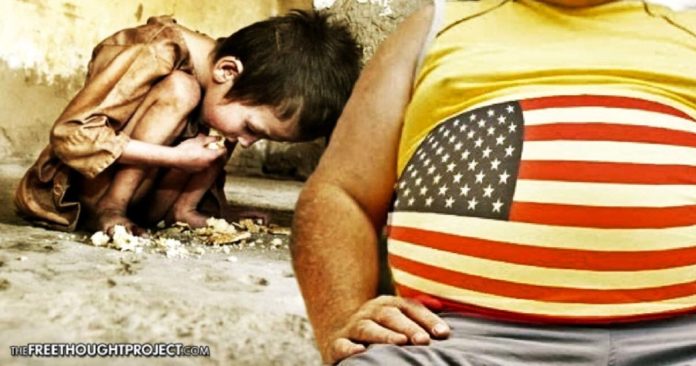
Obesity, a leading public health problem in the United States, affects more than a third of all American adults (that’s 78.6 million people). The heaviest Americans have become even heavier the past decade (another third of Americans are overweight). The Trust for America’s Health projects that 44% of Americans will be obese by 2030.
With one in three U.S. adults currently obese and with American teenagers currently on a weight gaining spree, more than two thirds of Americans are prone to higher rates of heart disease, high blood pressure, stroke, diabetes, cancers, arthritis, and Alzheimer’s disease.
While Americans not only have their plates but their bellies full as well, the world faces the worst food crisis since 1945, with more than 20 million people in four countries (Yemen, Somalia, South Sudan and Northeastern Nigeria) facing starvation and famine. Calling for a collective and coordinated global effort to avert a catastrophe, Stephen O’Brien, the UN under secretary-general for humanitarian affairs, recently told the Security Council in New York:
“We stand at a critical point in history. Already at the beginning of the year we are facing the largest humanitarian crisis since the creation of the United Nations. Now, more than 20 million people across four countries face starvation and famine. Without collective and coordinated global efforts, people will simply starve to death. Many more will suffer and die from disease.
“To be precise, we need $4.4 billion by July. Unless there was a major infusion of money, children will be stunted and out of school. Livelihoods, futures and hope will be lost. Communities’ resilience will rapidly wilt away. Development gains will be reversed. Many will be displaced and will continue to move in search for survival, creating ever more instability across entire regions.”
In Yemen, 3.3 million children and pregnant or nursing women are acutely malnourished; 18.8 million people (two thirds of the population) are food insecure; and more than 7 million people do not know where their next meal will come from.
A three-year civil war has uprooted more than 2.3 million South Sudanese; displaced nearly 3.7 million people; rendered over a million children acutely malnourished; and left more than 7.5 million people in need of urgent aid.
In Somalia, 6.2 million people (more than half the population) need emergency food assistance. More than 8.5 million people in three states in Northeastern Nigeria (Borno, Adamawa and Yobe) are severely food insecure; over $1 billion is needed to save and sustain their lives. O’Brien concluded:
“The situation for people in each country is dire, and without a major international response, the situation will get worse. The United Nations and its partners are ready to scale up, but need the access and money to do more. It is all preventable. It is possible to avert this crisis, to avert these famines, to avert these looming human catastrophes.”
Related: When #FirstWorldProblems Are Read By Third World People [Thought Provoking Video]
Are third world problems exclusive to third world countries? Would the United States ever face a similar humanitarian crisis? In 2015, 42.2 million people in the world’s most obese nation (read the U.S.) lived in food insecure households, including 29.1 million adults and 13.1 million children. According to Bloomberg News, one in seven Americans currently depend on food stamps (that’s 45.4 million people).
Is the U.S. prepared for a food crisis? The Free Thought Project writes:
“There are a few ways Americans can begin to prepare for unexpected food shortages. First, when buying dried goods, buy one or two bags more than you need. Second, begin to stock up on universal currencies such as silver and gold. Third, take a gun safety course.
“Fourth, have a bug-out bag, and a bug-out plan, so that in the event of some form of chaos, one can escape to safety with the basic necessities for at least a few days. Lastly, have a plan which includes a sustainable supply of fresh water. Without it, no one, not even the best of gardeners, can grow food.”
This article (As America’s Obesity Epidemic Hits New High, World Faces Worst Food Crisis Since WWII) is a free and open source. You have permission to republish this article under a Creative Commons license with attribution to the author and AnonHQ.com.
Supporting Anonymous’ Independent & Investigative News is important to us. Please, follow us on Twitter: Follow @AnonymousNewsHQ





